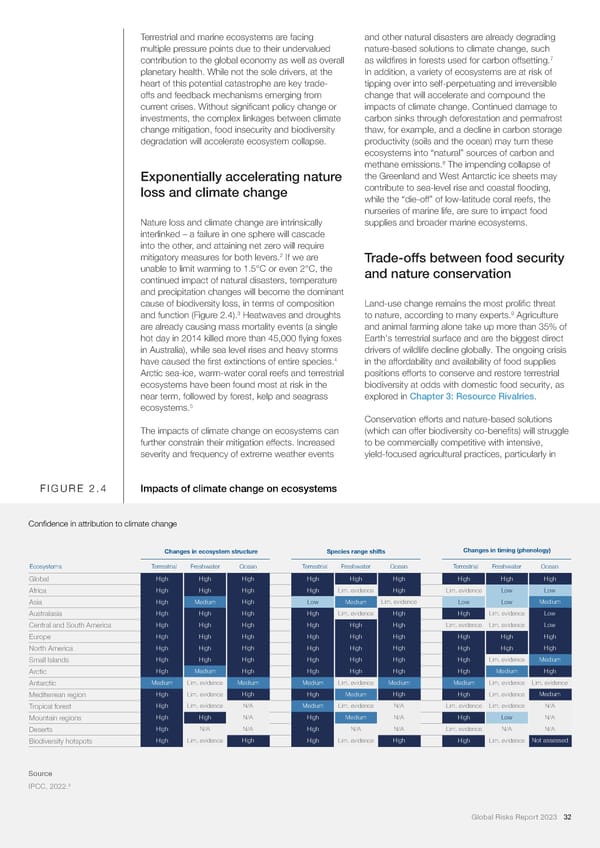Terrestrial and marine ecosystems are facing and other natural disasters are already degrading multiple pressure points due to their undervalued nature-based solutions to climate change, such contribution to the global economy as well as overall as wild昀椀res in forests used for carbon offsetting.7 planetary health. While not the sole drivers, at the In addition, a variety of ecosystems are at risk of heart of this potential catastrophe are key trade- tipping over into self-perpetuating and irreversible offs and feedback mechanisms emerging from change that will accelerate and compound the current crises. Without signi昀椀cant policy change or impacts of climate change. Continued damage to investments, the complex linkages between climate carbon sinks through deforestation and permafrost change mitigation, food insecurity and biodiversity thaw, for example, and a decline in carbon storage degradation will accelerate ecosystem collapse. productivity (soils and the ocean) may turn these ecosystems into “natural” sources of carbon and 8 methane emissions. The impending collapse of Exponentially accelerating nature the Greenland and West Antarctic ice sheets may loss and climate change contribute to sea-level rise and coastal 昀氀ooding, while the “die-off” of low-latitude coral reefs, the nurseries of marine life, are sure to impact food Nature loss and climate change are intrinsically supplies and broader marine ecosystems. interlinked – a failure in one sphere will cascade into the other, and attaining net zero will require 2 mitigatory measures for both levers. If we are Trade-offs between food security unable to limit warming to 1.5°C or even 2°C, the and nature conservation continued impact of natural disasters, temperature and precipitation changes will become the dominant cause of biodiversity loss, in terms of composition Land-use change remains the most proli昀椀c threat 3 9 and function (Figure 2.4). Heatwaves and droughts to nature, according to many experts. Agriculture are already causing mass mortality events (a single and animal farming alone take up more than 35% of hot day in 2014 killed more than 45,000 昀氀ying foxes Earth's terrestrial surface and are the biggest direct in Australia), while sea level rises and heavy storms drivers of wildlife decline globally. The ongoing crisis 4 have caused the 昀椀rst extinctions of entire species. in the affordability and availability of food supplies Arctic sea-ice, warm-water coral reefs and terrestrial positions efforts to conserve and restore terrestrial ecosystems have been found most at risk in the biodiversity at odds with domestic food security, as near term, followed by forest, kelp and seagrass explored in Chapter 3: Resource Rivalries. 5 ecosystems. Conservation efforts and nature-based solutions The impacts of climate change on ecosystems can (which can offer biodiversity co-bene昀椀ts) will struggle further constrain their mitigation effects. Increased to be commercially competitive with intensive, severity and frequency of extreme weather events yield-focused agricultural practices, particularly in FIGURE 2.4 Impacts of climate change on ecosystems Confidence in attribution to climate change Changes in ecosystem structure Species range shifts Changes in timing (phenology) Ecosystems Terrestrial Freshwater Ocean Terrestrial Freshwater Ocean Terrestrial Freshwater Ocean Global High High High High High High High High High Africa High High High High Lim. evidence High Lim. evidence Low Low Asia High Medium High Low Medium Lim. evidence Low Low Medium Australasia High High High High Lim. evidence High High Lim. evidence Low Central and South America High High High High High High Lim. evidence Lim. evidence Low Europe High High High High High High High High High North America High High High High High High High High High Small Islands High High High High High High High Lim. evidence Medium Arctic High Medium High High High High High Medium High Antarctic Medium Lim. evidence Medium Medium Lim. evidence Medium Medium Lim. evidence Lim. evidence Mediterrean region High Lim. evidence High High Medium High High Lim. evidence Medium Tropical forest High Lim. evidence N/A Medium Lim. evidence N/A Lim. evidence Lim. evidence N/A Mountain regions High High N/A High Medium N/A High Low N/A Deserts High N/A N/A High N/A N/A Lim. evidence N/A N/A Biodiversity hotspots High Lim. evidence High High Lim. evidence High High Lim. evidence Not assessed Source 6 IPCC, 2022. Global Risks Report 2023 32
 2023 | Global Risks Report Page 31 Page 33
2023 | Global Risks Report Page 31 Page 33